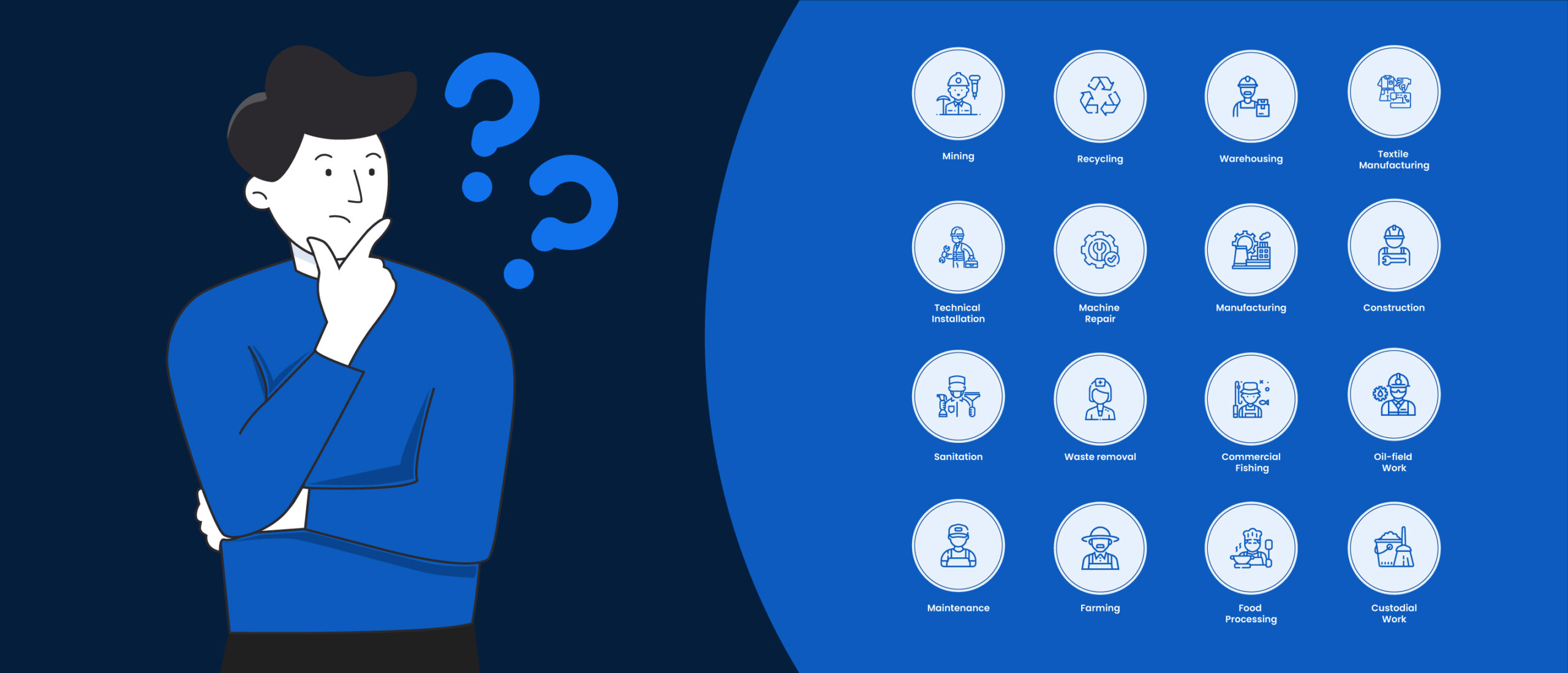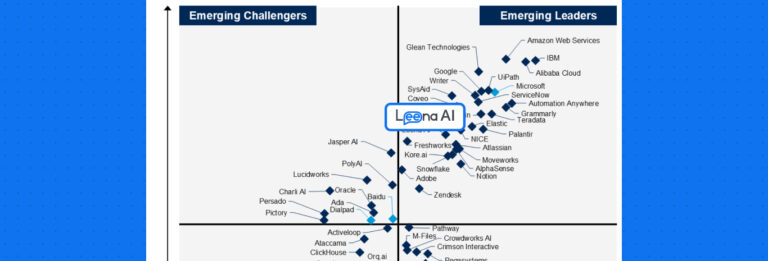While the internet has been flooded with discussions around the concerns and challenges that employees face during work from home, there is seldom talk of what life looks like beyond the white collar. As most of us have the privilege of WFH, the men in blue have to trudge around in their boots, working to keep organizations up and running, pandemic or no pandemic.
However, as the global labor market continues to disrupt, enterprises have made a paradigm shift in how they see blue-collar workers – from supporting staff to partners in the company’s success. As a result, organizations are moving past the ineffective, traditional onboarding methods and shifting towards modern solutions that are powered by AI.
Enterprises are prioritizing digital onboarding for workers in an increasingly distributed and complex environment to attract, engage, and retain them while ensuring their well-being and development.
Who are blue-collar employees?
Blue collar workers or frontline workers involve unskilled, semi-skilled, or skilled labor requiring formal education or specialization in performing specific tasks. They are paid by the hour or piece rate based on the amount of work they perform. Blue-collar work is mostly manual in nature. Examples of blue-collar jobs include

Why should you focus on enhancing your frontline workers’ experience?
Despite all the noise of automation superseding everyone, from factory workers to truck drivers, blue-collar work is not going away. Instead, the demand for front-line workers has grown exponentially. According to a report, from 2016 to 2026, the demand for derrick operators in oil and gas will rise by 26%, the need for plumbers, pipefitters, and steamfitters will go up by 16%, and the requirement for ironworkers will be up by 13%.
Frontline workers are an integral part of the workforce in organizations where industrial processes like manufacturing, warehousing, construction, maintenance, or processing occur and directly impact the revenue of the organization.
Therefore, organizations must keep frontline workers content and motivated for ensuring higher productivity. Employers who neglect their workers, risk trouble in terms of recruiting and retention, to say nothing of business results.
What are the challenges that organizations face while onboarding blue-collar employees?
Some of the common challenges that HRs face while implementing the existing onboarding program for frontline employees include:
Time-consuming and tedious manual processes
Most organizations use digital tools like Excel spreadsheets and messaging platforms to manually onboard frontline employees. HRs use these modes to relay important information like work responsibilities, shift timings, and to keep track of their working hours.
Not only this, some organizations even use WhatsApp groups or informal messaging platforms to communicate the work shift changes to workers. Such inefficient methods often lead to frustration among workers as they have to figure out things on their own, particularly in a chaotic environment. Ultimately, the organization ends up wasting time and money.
Lack of a standard onboarding process leads to inconsistent employee experiences
Having no standard process to onboard frontline workers leads to inconsistent employee experiences. It leads to inaccurate dissemination of information to every employee and hence impedes the productivity of new and existing frontline employees. Varying instructions and responsibilities also cause significant stress among workers and reduce their morale.
Lack of personalization curtails the assimilation of new employees
The traditional onboarding processes are not personalized to meet the needs of the workers who come from diverse backgrounds and speak different languages. The one-size-fits-all approach for onboarding the distributed frontline workers does not help in engaging, assimilating, and retaining them into the organization. As a result, they leave the organization in a shorter span of time.
No feedback mechanism to address the loopholes in the onboarding process
The existing onboarding process encompasses a set of instructions and general information about the organization and workers’ daily responsibilities. The process does not have the mechanism to collect workers’ feedback. As a result, the loopholes in the process never get addressed and the opportunity to improve different business areas go down in flames.
No visibility into the onboarding progress of new employees
HRs do not have the visibility to measure the onboarding progress of their blue-collar employees. Given this, HR team members are unevenly allocated to the new employees.
It leads to twofold disadvantages: first, HRs do not get time to focus on strategic tasks due to an inefficient process, and second, workers take more time in assimilating into the organization due to a slow start and unsystematic onboarding process.
Unclear roles and responsibilities
Due to the lack of sufficient resources and training material for blue-collar employees, they feel unsure of what is expected of them, leading to many errors and hence, wastage of valuable time and resources. Irrespective of the level at which a frontline worker is hired, you can not simply ask them to come in and start working immediately. It only leads to frustration among both parties.
Non-compliance with safety rules
With non-standardized methods for training workers, their safety gets jeopardized. In factories, safety rules are critical. However, many new employees fail to comply with them because of a lack of proper onboarding.
How to overcome blue-collar onboarding challenges with a digital onboarding solution?
Onboarding is a critical aspect of workforce management: getting it wrong can have an enduring impact. A manual onboarding process is more prone to human error, giving workers a negative impression of your organization and discouraging them from staying for longer in the company.
However, by digitizing the onboarding process for frontline workers, organizations can avoid the hazards of manual processes and enjoy the significant benefits of streamlined automated onboarding. Know how a digital onboarding solution helps:
Automates the entire onboarding process
Once your organization has mapped the onboarding process, you can automate every step involved in the onboarding process through a digital onboarding solution. A digital onboarding solution creates a standard and consistent process that runs like clockwork. HRs can set up automated reminders for each step, right from sending the contract, to collecting the desired documents, to ensure that no step is left undone.
The digital onboarding solution automates the HR tasks associated with administering onboarding and facilitates the organization in delivering an engaging experience to blue-collar workers. Great onboarding experiences maximize workers’ involvement and commitment while promoting the organization’s ethos and culture.
You can use intuitive, AI-driven onboarding software like Leena AI’s onboarding software to automate the onboarding process and let HRs focus on constructive ways of engaging and assimilating frontline workers into the new culture.
Our digital onboarding solution integrates seamlessly with third-party systems like WhatsApp to help enterprises stay connected with their frontline workers across any platform. Moreover, workers also find it easy to access the Leena AI platform on their preferred channel for viewing the required information anytime, anywhere.
Schedule a demo to know how it works!
Provides an easy-to-use interface for blue-collar workers
A digital onboarding solution not only eliminates the paperwork but also gives workers quick access to the onboarding activities and initial training that they can complete at their own pace.
The simple-to-use conversational interface uses natural language understanding (NLU) to let frontline workers interact with the smart virtual assistant in their natural language. The multilingual, AI-driven onboarding solution understands the vague interactions and provides relevant answers to address the queries of the workers.
It slashes the time managers and supervisors spend on answering the questions of workers, completing administrative tasks, such as getting the contract signed and providing information about different policies, such as leave, medical, insurance, and others.
Further, the digital onboarding system keeps blue-collar workers engaged with the training material, policies, procedures, and forms, without information overloading.
Abides by all the compliances
Navigating through compliance and legal documents is an uphill struggle since every country has its own state and central labor laws. And violations of these regulations can cause a number of legal issues for businesses, including fines and criminal tangles.
Therefore, organizations must use onboarding software to elucidate all the regulations and safety protocols for frontline workers on their first day. Taking acknowledgment from them helps enterprises maintain compliance and minimize risks.
Leena AI’s digital onboarding solution can aid enterprises in local and regional compliance as well when they work with frontline workers across different geographies.
Tailors the experience for every blue-collar employee
Digital onboarding software empowers organizations to tailor individual onboarding experiences. With the onboarding software, HRs can customize training and instructional content, considering the role and responsibilities of each employee.
Leena AI’s AI-driven digital onboarding solution enables HRs to set up custom workflows on the go for delivering personalized content to blue-collar employees based on their roles and designation in the organization. The relevant experiences eventually boost the loyalty and retention of frontline employees.
Enhances visibility through a centralized dashboard
The digital onboarding solution has a centralized dashboard to let HRs and organization leaders gain visibility into the progress of blue-collar employees’ onboarding program.
The stakeholders get a comprehensive and real-time overview of the status of the candidates getting onboarded. It helps HRs plan the onboarding activities better for employees without confusion.
Further, the analytics and reporting capabilities in the digital onboarding software enable organizations to identify the key areas for improvement in their onboarding journey.
Provides 24*7 support
Even after a seamless onboarding of frontline employees, they still have questions on how to clock in/out or how to perform some tasks. The digital onboarding solution provides employees the support by helping them raise support tickets on the AI-driven virtual assistant. The AI-powered systems save a lot of time for blue-collar employees and allow them to focus on becoming productive faster.
Best practices for onboarding blue-collar workers
A successful onboarding plan should help new employees assimilate seamlessly within the organization and embrace its culture, vision, and mission. So, follow these best practices to evolve the onboarding process for your frontline employees.
Take it from square one
Quite often, frontline workers are considered lesser than traditional employees. This disregard can be costly and cause businesses to miss substantial opportunities.
On the other hand, if companies onboard blue-collar workers kin to white-collar workers, it helps them immerse fully in the company and their day-to-day life in the workplace. Doing that makes them feel valued and conveys a strong message of equity and inclusion from the get-go.
Get the administration work done before the first day
Do not let frontline workers feel bogged down with several hours of paperwork on their first day at work. Instead, get the paperwork for payroll and identification, and employment done before day one via a digital onboarding solution. Provide workers a platform where they can access all the joining formalities and ask questions about insurance and other benefits whenever they want.
Craft the onboarding program diligently
Create an onboarding plan that consists of a thorough introduction to the workplace and covers everything that an employee needs to know to get started. Make blue-collar workers familiar with their work location and people whom they will be working with closely, such as managers, supervisors, and peers. Besides, they need to undergo safety training and should have an understanding of administrative procedures like clock in and clock out time.
Do not overlook technology AT ALL
Technology can be a benediction for onboarding employees, including frontline workers. Many organizations learned it the hard way when the pandemic struck. Organizations went haywire in ensuring that on-site employees have access to the relevant onboarding information and support as those working remotely.
Therefore, organizations should use onboarding solutions to ensure consistent and on-demand access to information to workers on a 24/7/365 basis. Craft a streamlined and effective onboarding program that offers foundational support and knowledge to the workers they need to do their jobs.
Create a feedback culture
Your blue-collar workers are essential for the success of your organization. Do not let them feel unappreciated and insignificant. Studies have shown that for many workers respect in the workplace is even more important than their salary.
Therefore, it is better to use a digital onboarding system to stay connected with your employees irrespective of their work location. The solution helps enterprises roll out regular surveys to the frontline employees to understand their pulse – to know what they feel about their workplace, how engaged they are, and if they need any kind of assistance.
Gather your workers’ feedback and analyze the results to address their pain points without any delay. This helps them understand that you care about their well-being and contribution to the organization. And in return, you will see devoted and productive employees!
Stay ahead of the curve by digitally onboarding blue-collar workers
While the current labor shortage is a critical problem for organizations across the globe, making your blue-collar workers feel valued, visible, and empowered can make a big difference in attracting and retaining them.
Perhaps the most important change you can make right now is to transform your onboarding process. Start leveraging a digital onboarding solution to show that you value frontline employees as partners in the success of your organization.
Leena AI’s digital onboarding solution is an AI-driven platform that enterprises can customize and scale for their blue-collar workers as and when the need arises. Our simple-to-use onboarding solution seamlessly integrates with third-party and conversational platforms like WhatsApp and SMS to help frontline workers access information 24*7 on their mobile phones in their preferred language and stay connected with their supervisors and HRs. This way, workers’ queries get resolved on the go without the need to visit the office. Additionally, organizations stay compliant with all safety and labor laws of frontline workers.
If your HRs are also caught up in the manual and repetitive administrative tasks while onboarding blue-collar employees, you have landed at the right place to begin the transformation! Look no further,







